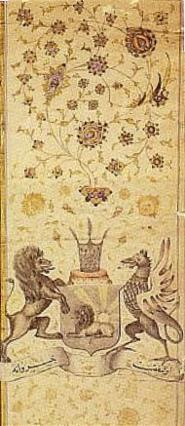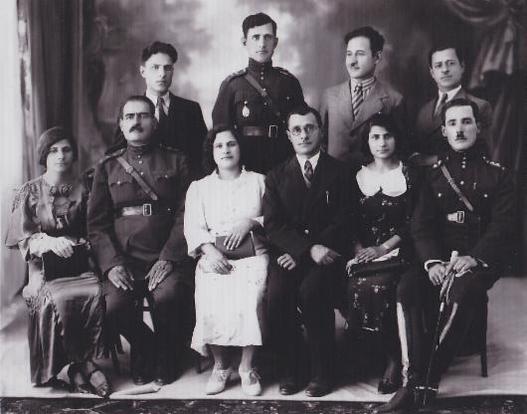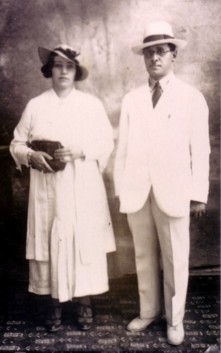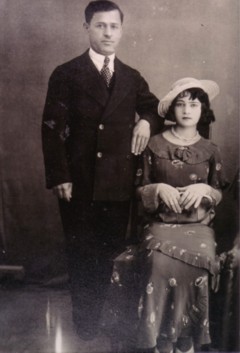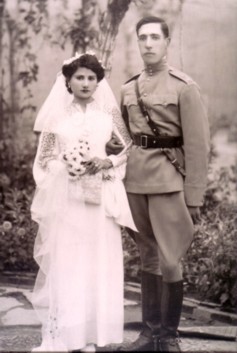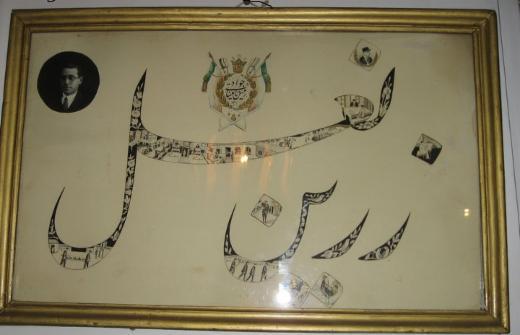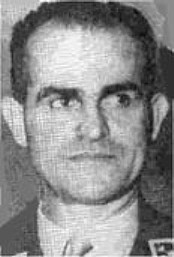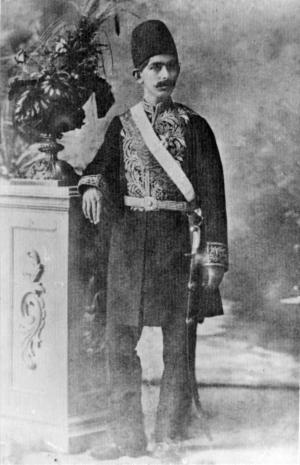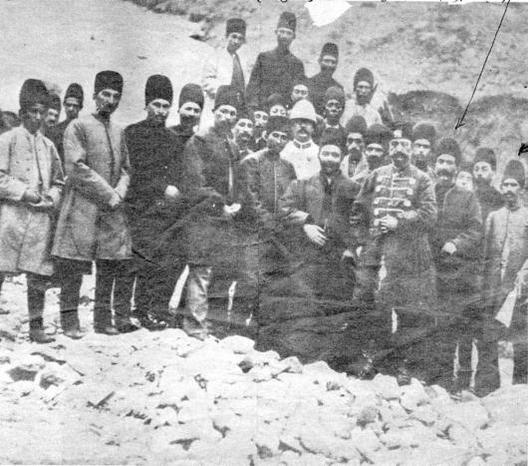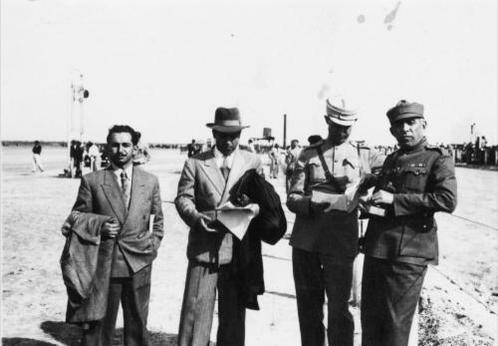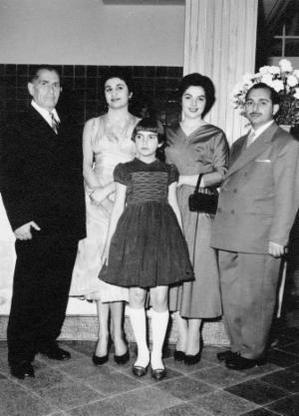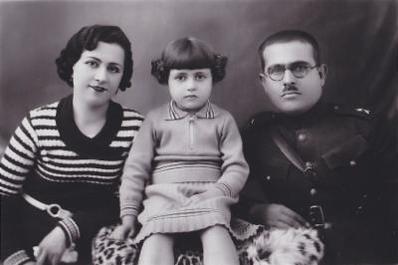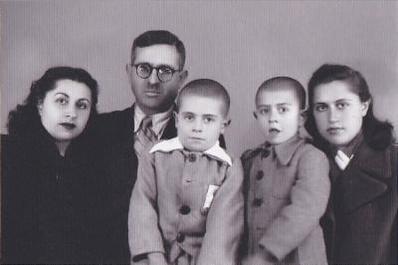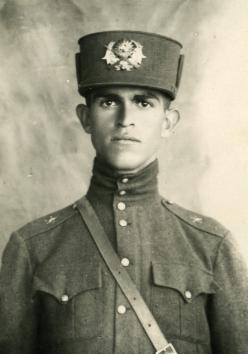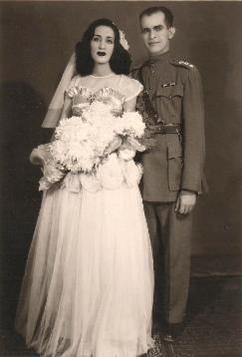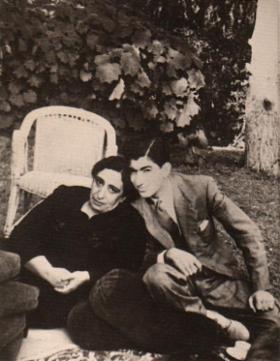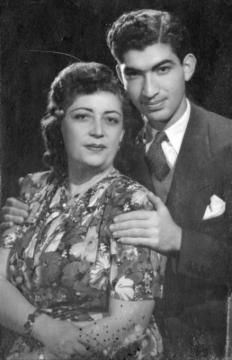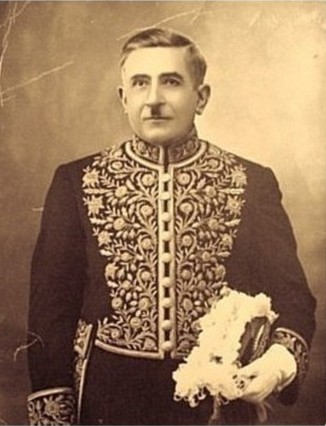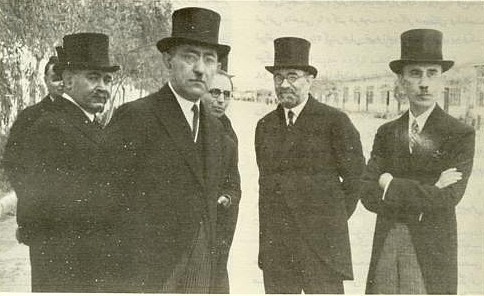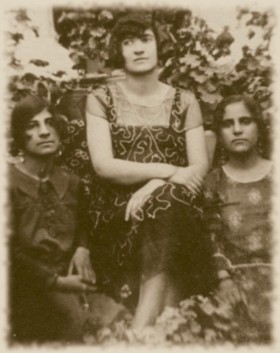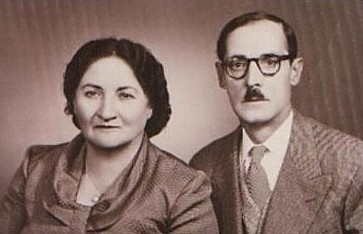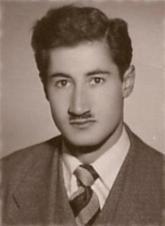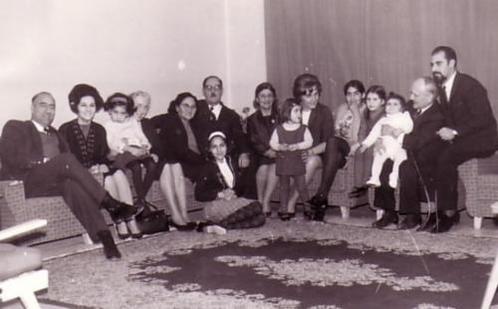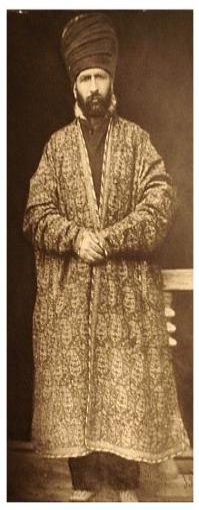| The Heroic and Historic Era The Kurdish Era The Qajar Era The Pahlawi Era | The Zarrinkafsch-Bahman (Qajar) Family |
When in 1925 the former soldier of humble origin Reza Khan "Maxim", assumed the Persian Peacock Throne, our
immediate own family, the House of Zarrinkafsch-Bahman, emerged in the
very same year. Reza Khan originated from Mazanderan and initially was
lieutenant-colonel (mirpanj)
in the Cossack division responsible of the Maxim machine gun. Later he
became "Sardar Sepah" (lit. "Head of the Armed Forces", i.e.
Commander-in-Chief) and finally finished the Qajar regime by founding
as Reza Shah Pahlawi his own Pahlawi dynasty (1925 to 1979). Under
the two Pahlawi rulers, Reza Shah (r. 1925-1941) and Mohammad Reza Shah
(r. 1941-1979), the members of the House of Zarrinkafsch-Bahman were
installed in several posts in diplomacy and military. From one side of
Kurdish origin from the other a branch of the Qajar princely line of
Azerbaijan, the House of Zarrinkafsch-Bahman was established when in
1925 Soltan Kazem Khan Zarrinnaal aka Kazem Zarrinkafsch, third son of Agha Mirza
Ali Akbar Khan-e Zarrinnaal
"Nasr-e Lashkar" by Roghiyeh Khanom Wali, married Nosrat ol-Molouk
Khanom Bahman (Qajar), daughter of H.H. Princess Malekeh-Afagh Khanom and Amanollah Khan "Zia
os-Soltan":
13. Kazem (Ali) Khan Zarrinnaal Zarrinkafsch "Sakar-e Sarhang" (1896-1971)
Colonel Kazem Khan "Sakar-e Sarhang" in 1939.
Agha Mirza Ali Akbar Khan-e Zarrinnaal "Nasr-e Lashkar's" third son by his second wife Roghiyeh Khanom Wali was Kazem (Ali) Khan Zarrinnaal Zarrinkafsch "Sakar-e Sarhang", called Dadash Mirza by his younger siblings and then Agha Jan (lit.
"Dear Sir") by his family. Named after the 7th Shiite Imam Musa
al-Kazim, he was born on 7th of November 1896 at Tehran, died 4th of
April 1971 by stroke in Kiel/Germany and was buried in the family mausoleum at Behesht-e Zahra near Tehran. (The mausoleum's eywan
or entrance hall was damaged by Islamic revolutionary troops in 1979
and the name's graffity of "Zarrinnaal" was destroyed by revenge
because of the family's infliction with the old regime and here
especially because of Ahmad Khan Zarrinnaal's duties in the Ministry of
Justice under Mohammad Reza Pahlawi!) After his grandfather, father and
eldest brother Nasir on-Nezal who became the third hereditary lashkar-newis and later sartip (lit.
"Leader", i.e. Brigardier-General or Two-Stars General) under Reza Shah
Pahlawi, Kazem Khan entered military service and studied at the Tehran
military academy Russian and artillery warfare. Then he was made
Lieutenant (nayeb) of Artillery, in 1924 Captain (soltan)
and then entered service of that Generalissimo Reza Khan, who became
the future Reza Shah Pahlawi and was in those days commander-in-chief
of the Qajar army and almighty minister of war.
Reza Khan introduced in 1922 a stringent classification of the army in several ranks with every soldier advanced by performance, period of service and seniority but not by his family background as in common under the Qajar aristocracy before.
Reza Khan introduced in 1922 a stringent classification of the army in several ranks with every soldier advanced by performance, period of service and seniority but not by his family background as in common under the Qajar aristocracy before.
When
captain of artillery in 1931 Kazem Khan was posted to Rezayieh
(Urmiyeh) in the western province of Azerbaijan, where a jealous
superior avoid his further career advancement. He did not catch the new
shah's eye until an inspection of the troops in 1934, when the shah
recognized, that Kazem Khan still was not forwarded, entitled him first
major (yasar) of artillery and in 1938 finally colonel (sarhang) of the Imperial Iranian army. He also received the Pahlawi's Imperial Order (neshan-e homayun) second class, with eight-rayed breast star and a red-bordered green ribbon, the former Decoration of Lion and Sun of Qajar times. Thereupon he went back to Tehran and his family moved to a villa in the Zarrinnaal's
city district on his father's former estates. All family members took
residence there on a huge park area between the Avenue Zarrinnaal and the Zarrinnaal-Alleys. Later the family moved to the cooler northern part of Tehran at the feet of Alborz-Mountains near to Tajdrish at Shemiran.
Here, Kazem Khan's youngest brother Ahmad Khan bought a huge rocky
desert area in the early 1940's. Cleverly he speculated with land,
earned a lot of money with re-saling of estates and constructed a
splendid huge dacha site with pools and a small river from the
mountains. His siblings joined him and finally moved from the old
southern family district in Tehran's East to this place. In the evening
times all relatives came together for gathering at the new founded
club-house of "Zarrinnaal
Club". With the Islamic Revolution in 1979 Ahmad Khan lost all his
possessions and the land had been nationalized. Now this area belongs
to a district called Seyyed Khandan. It is situated at present day Khiyaban-e Dr. Ali Shariati and Khiyaban-e Khajeh Abdollah Ansari, and there were apartment-buildings and a beautiful park (Park-e Zarrinnaal) erected there on the former private residential and club area. In
1946, tired of the corrupt Pahlawi regime, Kazem Khan quitted his
military service, retired to private life and carried on business in
road construction as well as he farmed his real estates at his village
of Zarrinabad next to the city of Qazwin.
Nearly
fourty years later then the first family picture: All children of Nasr-e Lashkar at Tehran 1940.
Sitting from left to right: Talat al-Molouk Khanom, Mohammad Ali
Khan "Nasir on-Nezal", Zarrin-Malek Khanom, Javad Khan, Sakineh
Zarrin-Homa Khanom, Kazem Khan. Standing: Ahmad Khan, Mehdi Khan, Jafar
Khan, Davood Khan.
The women of the Zarrinnaal family in their home's courtyard, from left to right: Zarrin-Malek with her nephew Ali Zarrinpour, Talat ol-Molouk, Nosrat ol-Molouk with her son Abdol Hossein Amir Keywan, Nayereh Khanom Zarrinnaal (the fourth wife and widow of Nasr-e Lashkar) and Sakine Zarrin-Homa with her niece Zarrin Rokh.
The Zarrinnaal siblings with their spouses in the early 1940's : Javad Zarinnnaal and
Ehteram ol-Waliyeh, Davood Zarrinnaal and Shams on-Nahar Wali...
Ehteram ol-Waliyeh, Davood Zarrinnaal and Shams on-Nahar Wali...
Ahmad Zarrinnaal and Badiyeh ol-Jamal Bahman (Qajar), Sakineh Zarrin-Homa Zarrinnaal
and General Mohammad Bagher Khashayar at their wedding ceremonies...
and General Mohammad Bagher Khashayar at their wedding ceremonies...
...Zarrin-Malek
Zarrinnaal and Mostafa Wali. All their offspring are today part of the
greater Zarrinnaal and Zarrinkafsch (Bahman-Qajar) Family.
Another
incident for breaking up relations with the Pahlawis happened in 1953
when the family's cousin Brigardier-General Mahmoud Afshartous, 6th son of
Kazem Khan's aunt Banou Fatemeh Soltan Khanom by her husband Hassan Khan
"Shebl os-Saltaneh" (Qajar-Quvanlu) was killed.
When Prime Minister Dr. Mohammad Mossadegh (r. 1951-1953), who was leader of the National Front, a liberal democrat and an ardent nationalist, more and more governed without parliament to reduce the Shah’s power, some politicians feared the democratic measures will end in despotism. Finally Mossadegh using emergency acts to reach his aim in nationalizing the Iranian oil industry organized a plebiscite to close parliament. The opposition saw in this fact a sign that he would ally with the communist Tudeh party, became a Soviet affiliated dictator and wanted to abolish the monarchy system in Iran. Thus, in 1953 Mozaffar Baqai, founding member of the Iranian Toilers’ party and a former companion of Mossadegh allied with General Fazlollah Zahedi, a close friend of the Shah, to depose Mossadegh. In Baqai’s house the conspirators gathered and planned the murder of Mossadegh’s loyal chief-of-police General Mahmoud Afshartous. An able general of the
Imperial army, Afshartous was made military governor of
Tehran and chief-of-police by his great-uncle in marriage
Mossadegh on 23rd of July 1952. But when he became too
popular and powerful to Mohammad Reza Pahlawi he was kidnapped,
tortured and strangulated to death by the Shah's agents on 24th of
April 1953. Hossein Khatibi who was responsible for Afshartous’ kidnapping and killing affirmed that documents had been found with Afshartous indicating a general arresting of all US-agents and Shah’s supporters in Iran. Afshartous’ fate was sealed and the plot against the democratically elected prime minister ended with the CIA-sponsored coup d’etat of 19th of August 1953.
For a full article about General Mahmoud Afshartous on WIKIPEDIA please click - here
The US-magazine TIME fully reported in an article "In a Persian Alley" Monday, May 04, 1953:
"At 45, ruggedly handsome Brigadier General Mahmoud Afshartous was Iran's top cop. He played no politics, and he enforced the law impartially, an attitude so exceptional in Iran that it seemed somehow vindictive. Four months ago Mohammed Mossadegh, his great-uncle by marriage, appointed Mahmoud chief of the National Police. He was reportedly slated to head up the army too, as soon as Mossadegh pried it loose from the Shah. Mahmoud was going places.
One evening last week, the usually precise Mahmoud arrived at his office two hours late. He riffled through his mail until he found one letter, which he read and reread several times. At 9 p.m., his other mail still unread, Mahmoud buckled on his pistol, took his briefcase, and told his driver to drop him off at Khaneghah Avenue. He left his briefcase and revolver behind in the Buick, set off along Khaneghah Avenue, an alleylike street honeycombed with apartments. He paused for a moment in a grocery, inquired of a boy there the address of a Hossain somebody (the boy could not remember the rest of the name), walked out and vanished.
"At 45, ruggedly handsome Brigadier General Mahmoud Afshartous was Iran's top cop. He played no politics, and he enforced the law impartially, an attitude so exceptional in Iran that it seemed somehow vindictive. Four months ago Mohammed Mossadegh, his great-uncle by marriage, appointed Mahmoud chief of the National Police. He was reportedly slated to head up the army too, as soon as Mossadegh pried it loose from the Shah. Mahmoud was going places.
One evening last week, the usually precise Mahmoud arrived at his office two hours late. He riffled through his mail until he found one letter, which he read and reread several times. At 9 p.m., his other mail still unread, Mahmoud buckled on his pistol, took his briefcase, and told his driver to drop him off at Khaneghah Avenue. He left his briefcase and revolver behind in the Buick, set off along Khaneghah Avenue, an alleylike street honeycombed with apartments. He paused for a moment in a grocery, inquired of a boy there the address of a Hossain somebody (the boy could not remember the rest of the name), walked out and vanished.
At
1 a.m. Premier Mossadegh was roused from bed with the news of the
disappearance; within a few minutes 500 cops rushed into the area where
Afshartous was last seen.
Khaneghah Avenue was a strange alley for Iran's top cop to venture into unprotected. Some of Mossadegh's bitterest enemies made their headquarters there, including the Retired Officers' Association and the Fascist-like Sumka Party. But it is also home to several notorious easy women, and Tough Cop Afshartous had a reputation for philandering.
Khaneghah Avenue was a strange alley for Iran's top cop to venture into unprotected. Some of Mossadegh's bitterest enemies made their headquarters there, including the Retired Officers' Association and the Fascist-like Sumka Party. But it is also home to several notorious easy women, and Tough Cop Afshartous had a reputation for philandering.
The
principal pro-Mossadegh daily, Bakhtar-e-Emruz, hinted broadly: "It is
known that the general did not go out of his way to avoid the company
of women." The police picked up Tamara, a faded femme fatale, Teheran's
top belly dancer two decades ago, along with another dancer named
Helene and a tall, hard Rumanian barmaid called Nelly. But they knew
nothing, and were released. Then the cops went looking for—but could
not find—General Fazlollah Zahedi, head of the Retired Officers'
Association and an avowed anti-Mossadegh plotter. The government
offered 500,000 rials (about $15,000) for information, and promised
amnesty to anyone producing Afshartous.
Patiently
cops plodded from door to door, looking up all the neighborhood
Hossains, a job comparable to checking all the Joes on Chicago's South
Side. When they came to the home of Politician Hossain Khatibi, once a
prominent supporter of Mossadegh and now loudly in opposition, they
were bothered by the heavy smell of perfume mixed with another,
hard-to-place odour. Under questioning, the servants cracked: the other
smell, which the perfume was intended to hide, was chloroform.
Gradually
the whole story came out. Mahmoud Afshartous had gone to Khatibi's home
that fateful night, lured by an offer to act as mediator between
Mossadegh and his antagonists. Waiting plotters grabbed him, he
struggled, was finally subdued and chloroformed. The plotters hauled
Afshartous off into the mountains near Teheran, tortured him, finally
garroted him to death. This week the cops found the corpse, roped
around the neck, hands and feet, in a shallow grave beside a road
outside Teheran. They arrested Khatibi and several brigadier generals,
associates of the missing General Zahedi.
Mossadegh
ordered Afshartous' flag-draped coffin borne through the streets of
Teheran on a caisson; and proclaimed a day of national mourning. The
day of Afshartous' burial marked the second anniversary of Mossadegh's
taking power."
Mahmoud Afshartous' family goes back to Agha Mirza Zaman Khan Kordestani "Lashkar-nevis" and Pari Soltan Khanom Pir-Bastami's only daughter Banou Fatemeh Soltan Khanom and her husband Hassan Khan "Shebl os-Saltaneh". Shebl os-Saltaneh (lit. "Lion Cub of the Monarchy") was the oldest son of Mohammad Khan Afshar "Sartip" by Mala Abu Khanom, the widow of Amir Issa Khan Vali "Ehtesham od-Dowleh" Qajar-Quvanlu "Amir Kabir". Thus, Hassan Khan was the younger half brother of the famous Mehdi Qoli Khan Amirsoleimani "Majd od-Dowleh". So, via his mother's side he was related with Mahd-e Oliya and a cousin to Nasser od-Din Shah. His career
at court started 1868 as gholam or page boy in the royal andaroon. He became chief page known as Hassan Khan Afshar "Bashi" and until 1896 he was personal adjudant (ajudan-e hozour-e homayouni) to Nasser od-Din Shah whom he accompanied with his brother on several trips. Later he hold different posts and was entitled "Shebl os-Saltaneh". When family names were mandated his family was named "Afshar-e Tous" meaning Afshars of the City of Tous or finally Afshartous. The Afshartous family were six brothers and two sisters, who intermarried with their relatives from the Amirsoleymani (Qajar-Quvanlu) and Zarrinkafsh lines. Mahmoud Afshartous was the 6th son and twice close related to the Pahlawis via Queen Touran Khanom
Amirsoleymani (Qajar-Quvanlu) "Qamar ol-Molouk". Queen Touran was the third wife of Reza Shah Pahlawi, who married him 1922 and was divorced one year later.
Once the Queen was closely related to Afshartous' own father Shebl
os-Saltaneh and twice Mahmoud Afshartous had married Fatemeh Bayat, daughter of Qods-e Azam Atabaki, the maternal aunt of Qamar ol-Molouk. Therefore, the Queen's only son Prince Gholam Reza
Pahlawi, the Shah's half brother, came to Banou Fatemeh Soltan's house as envoy and representative of the Pahlawi
monarchy to condolence Mahmoud Afshartous' family. But Banou Fatemeh
Afshartous, then an old little lady out of grief for her dead son,
bravely asked the prince: "I am wondering that my son's murderer sent you to come here. What did my son do wrong than only being a real patriot who loved his country? What did my son do wrong in the eyes of his murderer, the Shah, your brother?" Ashamed the prince left that funeral cometogehter and our family cut officially any relations with the court.
Nasser od-Din Shah Qajar with his hunting party. First row from right to left: Shebl os-Saltaneh Afshartous with a riffle, his elder brother Majd od-Dowleh Amirsoleyman, the Shah, Amin os-Soltan Atabak-e Azam, Fakhr ol-Molk Ardalan, Asaf od-Dowleh Shirazi, Majd os-Saltaneh, N.N., a black servant.
Banou Fatemeh Soltan Afshartous (sitting right) with her children Ali Afshartous (far right), Mahmoud Afshartous (far left), Fatemeh Bayat-Afshartous, Malek Zaman and Simin and grandchildren, 1948.
The Afshartous brothers: Fath Ali Afshartous and his uncles Ali Afshartous and General Mahmoud Afshartous...
Prince Gholam Reza Pahlawi with his aunt Qods-e Azam Atabaki and mother Queen Touran.
In
1930 Reza Shah had decided that all Iranians should carry family names
like in Europe. Until then in Persia a person's name was composed of
the traditional Islamic parts of first name (esm), a sobriquet (kunya), the father's name (nesab), name of provenience and sometimes a personal title (laqab).
But family names as a surname were not common. At the same time with
the new law and right to a name the shah abolished officially all
former titles of the aristocracy. With his siblings
Kazem Khan adopted the former title of Zarrinnaal as their common family name of Zarrinnaal, while his uncle Mirza Ali Asghar Khan chose the clan's name of Zarrinkafsh as his surname and then was called Ali
Asghar Zarrinkafsh. Thirteen years thereafter in 1943, Kazem Khan named
himself Zarrinkafsch, too, after he fell out of with his younger
brother Jafar Khan. Kazem Khan demanded from the family to avoid any
contact to Jafar Khan, who, according to Kazem Khan, should have treat
badly his young bride Fahimeh Khanom. The family of course kept contact
furthermore with Jafar but Kazem Khan did not want to bear the
same family name than his younger brother anymore and then changed it.
Finally on his deathbed he wanted to make peace with his brother and
renamed but failed because Kazem was in Germany and Jafar in Tehran.
This is why his family branch furthermore is know by the family name of Zarrinkafsch although the fully belong to the Zarrinnaal family!
Another
visible mark in Iran's public life to make the country more Western "modernized" was made by Reza Shah in 1936 with the abolition of
veiling in the streets. Henceforth women's traditional veil and
headscarf were forbidden in Iran and men were not allowed to wear
beards but were forced to wear Western attire. So people's wardrobe
dramatically changed and then women wear large hats and long dresses
instead of the former tshador. Commemorating this rule there was an official celebration
with military commanders of the Iranian armed forces, government
officials and their wives. Finally, his son Mohammad Reza Shah Pahlawi
lifted the ban on veils but from this time the modern women in our
family dressed like those in Europe or the United States.
The Iranian Oil Question
Iran's wealth based firstly on her mineral oil sources. For a long time this
resource was a controversial subject of the several political powers in that
area. At the turn of the 19th century the British Navy changed her charcoal-fired steam-driven
cannon boats into warships with engines running by oil. Thus, oil became very
important and British geologists knew about immense sources of mineral oil at
the shores of the Persian Gulf in Iran’s South. At that time the
Persians had neither the technical knowledge nor the facilities to handle the
new found oil. On 18th May 1901 Mozaffar od-Din Shah gave the Anglo-Australian
Prospector William Knox d'Arcy a concession to exploit all of Iran's oil
fields for the term of 60 years (until 1961). D’Arcy paid for the concession a
unique sum of 200,000 Gold Francs and offered the shah 16 percent of all future
profits. But the main part still remained for the British. In 1903 the “First
Mining Rights Exploitation Company” was found which started with several oil bores
in the Bakhtiari tribal area of Masjed-e Soleyman. There, since antiquity in
Persian temples eternal flames were fed by naphtha from natural oil sources
there. After negotiations with some tribal chiefs the “Bakhtiari Company” was
found. Also in Persia’s
north and east new companies were found by Russians and Americans. But on 14th
April 1909 by orders of the British admiralty, which was responsible for the
machinery’s transportation and British subjects’ safety, all companies in Persia were
united under the roof of the new found “Anglo-Persian Oil Company” (APOC). This
consortium finally was successful in finding rich oil fields, and in 1911 the
refinery of Abadan as centre of oil industry in Persia was put
into operation. On an area in southern Persia of 24 square miles 200
oil-well derricks were erected the following 20 years. Between 1911 and 1925
these derricks carried more than 10 million tons of oil. The profit is so high
the company counted with an asset of 26 million Pound Sterling in 1931. The production was raised
from 43,000 tons per annum to 7 million tons. Former net gain of the
“Anglo-Persian Oil Company”: 7 million Pound Sterling. Only 16 percent got the Persians.
Now, Reza Shah demanded further agreements with the British, quitted the contract
of 1901 and new negotiations started. They ended with the agreement of 29th
April 1933 between the “Anglo-Persian Oil Company” now called “Anglo-Iranian
Oil Company” (AIOC) and the Iranian government. The confession now was extended
until 1993 but the exploiting area was only the half than before and Iran’s dividend was 20 percent plus a single
bonus of one million Pound Sterling,
paid immediately after signing the contract.
Responsible for the
negotiations with the British was one prominent family member, our uncle Mr Ali Asghar Zarrinkafsh.
He was the very first one who bore our family name as last name. Born as Mirza Ali Asghar Khan, second
son of Agha Mirza Zaman Khan Kordestani and younger brother to Agha Mirza Ali Akbar Khan, he fist
became tutor (ostad) of English and Russian to Soltan Ahmad Shah Qajar and
finally with his skills in languages started his career in the diplomatic
corps. In the time of Reza Shah Pahlawi Ali Asghar Zarrinkafsh
was the Iranian Government’s representative or Imperial Delegate
to the
Anglo-Iranian Oil Company between 1933 and 1939 and became an important
figure entitled like the Iranian Minister “His Excellency”. He made
reputation
when in November 1933 he was sent by the Iranian Government to Abadan,
the centre of Iranian oil refinery,
for negotiations with AIOC about the status and number of Iranian
employees in
the Company. But furthermore to the new agreement, the Iranian
Government
wished to strengthen its influence in the British dominated oil
industry in Iran and to
replace foreign workers by native Iranians. H.E. Ali Asghar Zarrinkafsh
claimed that the foreigners’ supply and equipment by the Iranian
government was
a burden for the state finances. Thus, AIOC suggested that the Iranian
government should make a draft plan which suits more their purposes and
Zarrinkafsh was assigned to create proposals for a further discussion.
On the
other side the British informed the Iranian Government that their
foreign
employees would not replaced by Iranian personnel and offering a
training for
them by the British was nothing more than a purely voluntary one.
Finally, in
April 1935 Zarrinkafsh, who refused to give a draft plan in the sense
of the company, went in negotiations with the British representative
Neville Gass who
was in charge of Iranian concessionary affairs for the company in
London. Between June and
August 1935 both men started to find an agreement which took place with
meeting
of AIOC’s president Sir William Fraser and Ambassador Hossein Ala, the
Iranian
Minister to Court of St. James, in March 1936 and ended with signing
the
General Plan document on 2nd of April 1936. AIOC granted additional housing and
supplies as well as building a technical school for the higher training of the
Iranian employees if Iran could assert that it would improve its own
educational facilities to train suitable Iranians in these jobs. Beside his diplomatic status and official duties in Great Britain, Zarrinkafsh became a personel friend to the Prince of Wales, the future King Edward VIII. In the late days of Reza Shah's reign Ali Asghar Zarrinkafsh
worked for the Iranian state in the Ministry of Finances, and until his retirement 1951 he was
headman of the Counsil of State's Developement and Progress at last under Dr. Mohammad
Mossadegh, who finally nationalized all of Iran's oil by act of parliament of 30th April 1951.
H.E. Ali Asghar Zarrinkafsh
was also one of those men who gathered to the “Iran Society”, a
non-political scientific organization, which came into being on 19th of
November 1935 when a seemingly self-appointed Council meeting was held
at the Iranian Legation, 10 Princes Gate, London, under the
chairmanship of H.E. Ambassador Hossein Ala. The others present were Ali
Asghar Zarrinkafsh, Lord Lamington, Professor R. A. Nicholson and
Messrs. Laurence Binyon, Alfred Bossom, E.H. Keeling and Basil Gray.
In 1925 Soltan Kazem Khan married as his second wife, after his first marriage by whom he had his eldest son Darius (who died by accident in early infancy) was divorced, Nosrat
ol-Molouk Khanom Bahman (Qajar), Princess Malekeh-Afagh Khanom
Bahmani-Qajar's daughter by Mirza Amanollah Khan Tabrizi
Qajar-Zafarkhanlu "Zia os-Soltan" (to see her family see: The Bahman (Qajar) Ancestors). Nosrat ol-Molouk Khanom (lit. "Victory of the Kings"), called Khanom Jan ("Dear Lady") by the family, was born in 1899 at Bagh-e Shah in Tehran, died at 12th of December 1972 and was buried at her husband's side in the Zarrinnaal family mausoleum at Behesht-e Zahra. She was educated privately next to the general main lessons in French and a typical Qajar beauty.
Nosrat ol-Molouk Khanom Bahman (Qajar) with two
of her sisters-in-law in the gardens at Tehran in 1927.
of her sisters-in-law in the gardens at Tehran in 1927.
About the first meeting of both and their later marriage it is said that female relatives told Kazem Khan about a beautiful young woman from a good family in
Khiyaban-e Ferdowsi at Bagh-e Shah,
the daughter of Mirza Amanollah Khan "Zia os-Soltan" and H.H. Princess
Malekeh-Afagh Khanom Bahmani-Qajar. On a promenade to the bazaar he
could take a first look on her and decided to ask her father for her
hand. Then,
one day Zia os-Soltan came to see his old friend and political opponent
Nasr-e Lashkar and asked him, if he knows in military a lieutenant of
artillery called Kazem Khan, who was interested in his own daughter.
Nasr-e Lashkar asked for the division unit of this young officer and
then answered Kazem Khan is his own son. When Zia os-Soltan heard that
the candidate was his old friend's son and therefore came from a good
family, too, he did accept a future marriage between both houses. The
marriage was a love-match unusual in those days, and by Nosrat
ol-Molouk Khanom, Kazem Khan had issued five children, four sons and
one daughter: Abbas (born in 1926, who died in infancy),
Zarrin Rokh called "Zar Zar" or "Zarri" by the family (born on 4th of August 1929),
Ali Zarrinpour called "Pouri" (born on 4th of December 1930), Abdol Hossein Amir Keywan called "Keywan" (born on 31rst of December 1933) and Abol Reza Anushiravan called "Nushin" (born in 1935 and died in 1937 by typhoid fever).
The family often gathered in their house for festival events, and the unmarried sister Talat ol-Molouk Khanom lived there with them, too. During the holidays like Ashura the old black African servants of Nasr-e Lashkar, Assad Khan (!) - who later worked for the Bayani family - and Banafsheh Khanom ("Lady Viola") came to their house in Kucheh-ye Zarrinnaal to pay them obedience and condolence. So both received the old family servants respectfully in the official hall and gave them their usual benefits to support their living conditions, which was normal in those days!
Kazem Khan's wet nurse also was supported by them as well as her two daughters Belgheis Khanom and Tuba Khanom. Tuba Khanom, the older, once told that at the age of twelve she had been babysitting at a family. The infant was sick and to calm the child she gave him some seeds of opium as medicine. The baby slept away but when the poor parents arrived the baby was dead because the dose was too high….
Nosrat ol-Molouk Khanom Bahman and Kazem Khan Zarrinkafsch.
14. Our Parent's Generation: Zarrin Rokh, Ali Zarrinpour and Keywan Zarrinkafsch (Bahman-Qajar)
Nosrat ol-Molouk Khanom and Kazem Khan with their children, Abdol Hossein Amir Keywan, Zarrin Rokh with little Abol Reza Anushiravan and Ali Zarrinpour, in Rezayieh 1936.
After
the family moved back to Tehran, the children rose up there in the
privileged upper-class during a time of socio-political changes in Iran
under the reign of Mohammad Reza Shah Pahlawi.
Because the families of Zarrinnaal, Zarrinkafsch, Bahman and Wali
resided nearby in the same district and their offspring had nearly the
same age, the children rose up and spent their free time and holidays
alltogether at the countryside, in the mountains north of Tehran, on
the large park estates of their relatives and families with picnics,
hunting and family gatherings. Like many aristocratic
children they were sent for further education to study in Europe. Zarrin Rokh studied sometimes in England and Ali Zarrinpour and
Keywan in Germany after finishing the prestigous Dar ol-Fonun school and Alborz College.
Abdol Hossein Amir Keywan Zarrinkafsch (Bahman-Qajar) in Tehran 1941, 1946 and 1956.
In
1956 Keywan came to Germany as student at the age of 23. Even as a
teenager he was a political activist and wrote short stories, novels
and theatre plays with a critical political context about the social
injustice and political immaturity of the Iranian society. Then he
joined the social-democratic party of the Iranian Prime Minister Dr.
Mohammad Mossadegh, the Iranian National Front (Jebhe-ye Melli Iran).
But when he became suspicious for rebellion in the eyes of the SAVAK
secret service he had to leave the country totally. In Mainz/Germany he
studied firstly medicine but then, when SAVAK forced his parent's to
finish sending money for tuition fees, he had to cancel his studies.
After doing several jobs to be able to pay the tuition fees he began
his studies in economical studies, sociology, political studies and
philosophy he graduated in 1974 with diploma. After that he worked for
the Bank Melli Iran in Hamburg and was head of the revision department until his retirement in 2002.
In
Kiel he married on 19th of May 1972 Margrit Eva-Maria née Gentes, by
whom he has a son, Arian Kazem Zarrinkafsch-Bahman. In 1977
they moved to Hamburg.
Part
of the Zarrinkafsch (Bahman-Qajar) family in 1967 at Tehran: Nasser
Samiian, Zarrin Rokh Zarrinkafsch (Bahman-Qajar), Atoosa
Samiian, Elise Holz-Haendel, Nosrat ol-Molouk Khanom Bahman (Qajar),
Aryana Samiian, Kazem Khan Zarrinkafsch, Talat ol-Molouk Zarrinnaal,
Suzan Zarrinkafsch, Elke Zarrinkafsch, Azita Samiian, Sogand
Zarrinkafsch, Sunja Zarrinkafsch, Max Holz, Ali Zarrinpour Zarrinkafsch
(Bahman-Qajar).
Abdol Hossein Amir Keywan and Margrit Eva-Maria Zarrinkafsch (Bahman-Qajar).
15. The next Generation: Arian Kazem Zarrinkafsch-Bahman
Arian Kazem Zarrinkafsch-Bahman was born on
28th of July 1973 in Kiel, Germany. He was educated at primary school
Schenefelder Landstrasse, Hamburg 1980-1984, at grammar school
Gymnasium Willhoeden Blankenese, Hamburg 1983-1993, civil service
1993-1995. He studied history in the Middle-Eastern-Studies department of Asien-Afrika-Institute at Hamburg University focused on Iranian history, with a Master thesis about "Change and Development in 19th century Qajar court elite's self-image and clothing in painting and photography". He worked sometimes for Hamburg University as tutor in Middle Persian.
Since 1992 member of the German-Iranian Society and since 2002 of
International
Qajar Studies Association (IQSA) and of Kadjar Family Association
(KFA), as well as co-author in Qajar Studies: The Journal of the
International Qajar Studies Association, Vol III (2003), Vol VIII (2008) and Vol X (2010). Since 2001 he works for an optician enterprise in Hamburg.
The Family Arms of the Zarrinkafsch-Bahman family: Azur, a sun Or above all on a base Vert a rock Argent with a lion couchant guardant Argent.
To go back Home - click here
This website was created by Arian K. Zarrinkafsch (Bahman-Qajar).

